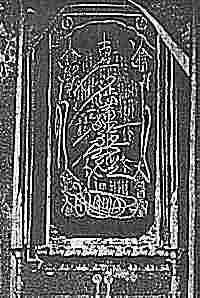
(Counterfeit Wooden Honzon).

(Counterfeit Wooden Honzon).
Note:In 1956, Yasunaga Bentetsu wrote the "Ita Honzon Gisaku Ron" . . .
Insofar as can be ascertained from the one circulated photograph
of the so-called "dai- gohonzon" (taken in 1910, with permission of Taisekiji), the handwriting is VERY peculiar. Nichiren's handwriting has been carefully studied and catalogued by the late Suzuki Ichiro and Yamanaka Kihachi. The handwriting of the so-called "dai gohonzon" is from the 3rd year of Koan (1280), not the 2nd year of Koan (1279), which is the formal date on the "ita mandara". It is almost a carbon copy of a genuine Nichiren gohonzon of 1280, now at Myokaiji in Numatsu near Fuji. It is important to note that the SGI/NST gohonzons, inscribed by various high priests of Taisekiji, are VERY different, both in form and content, from the so-called "dai-gohonzon". Certain placement of kanji have been conspicuously altered, and phrases has been added to the
body of the honzon. Such phrases never appeared in any other Nichiren gohonzon, and are incongruous with the nature of the gohonzon.
(These are the phrases referring to "gain" and "loss", on either side of the SGI/NST honzons). The SGI/NST honzons claim to be faithful copies
of the so-called "dai-gohonzon" but they are very different from the prototype, especially with regard to the size of the kanji in Nichiren name and his "kao" ("flower stamp"). In general, the size of the Daimoku is larger than that found on Mandalas written in 1279 and before then. This size of Daimoku was found on gohonzons from 1280, 1281 and 1282. So, the so-called "dai-gohonzon" is only consistent with gohonzons from 1280 and beyond.
Here's the contents of Chapter 3:"Chapter 3- False writings on the Ita Honzon:
1. Believers in the Ita Honzon have been punished. This is proof that
Nichiren Shoshu is an evil religion. pg. 1192. The facts about the Ita Honzon: "The false writings were written by
those who did not even know the meaning of 'Sandaihiho Sho' " pg. 1213. Yashiro Kunishige, the leader to whom the Ita Honzon is dedicated to, is
unknown. Thus, the sect made up the story that he died a martyr.4. Nichi-u, the 9th High Priest of Taisekiji Temple, died of leprosy, which
is a punishment for blaspheme of the Lotus Sutra.5. Many priests of Nichiren Shoshu came down with sicknesses like palsy and
leprosy, went crazy and died pg. 127 (History of these priests is covered
in Chapter 1)6. "Shonin Gonan Ji" (On the Persecution (or Difficulties) befalling the
Saints, written in 1273), one of the documents of Nichiren that is used as
evidence of the Ita Honzon's authenticity, has no connection with the Ita
Honzon pg. 1297. There was no mandala given to Nikko pg. 130
8. Nikko strictly forbade the production of wooden honzons such as the Ita
Honzon.9. The 3rd and 4th High priests of Taisekiji never mentioned the Ita Honzon
in their writings p. 13210. Nikko's disciples were also opposed to the making of any Ita Honzon.
11. Ita Honzon of Taisekiji appeared about 200 years after Nichiren had
died. pg. 13512. Why did Nichi-u forge the Ita Honzon? pg. 138
13. Camphor trees do not grow in the mountains; they are found only in
subtropic areas. The ita Honzon, therefore, could not have been made in
the mountains pg. 14014. Nippo ( supposed sculptor of the Ita Honzon) never made statues of
the Buddha or the Ita Honzon at Nichiren's Minobu hermitage pg. 14215. Nichiren Shoshu is skillful at falsifying documents, books, etc. p.
14316. The signatures (Nichiren's and the one of the Ita Honzon) are
different pg. 14517. The size of the kanji of the Ita Honzon did not exist in mandalas made
in 1279. The characteristic size of all mandalas by Nichiren in 1279 were
about 5/8th ( almost half) the size of those of the Ita Honzon. The size of
the kanji of the Ita Honzon are only found in the authentic mandalas of 1280,
such as the authentic mandala at Myokaiji, which bears a strong resemblance
to the form of the Ita Honzon pg. 14618. Evidence of falsification: the way the kanji for "kyo" is written is
different from Nichiren's handwriting. #a-f... Proof that the signature is
a false one: style, size, etc. pg. 14619. The Ita Honzon is a forgery by a person who didn't know Nichiren's
styles of writing from year to year pg. 15220. The Ita honzon that was dedicated to Taishakutenno was a fake
pg.15521. The Ita Honzon closely resembles Myokaiji's mandala (Myokaiji is
in the Fuji area) pg.15622. The Ita Honzon of Taisekiji is an imitation of Myokaiji's mandala
#a-d.... Evidence that the Ita Honzon imitated sentences, words, etc. from
the Myokaiji Mandala23. The Ita Honzon of Taisekiji was falsified by a vicious man with no
faith, moral code, or ethics pg. 162.The contents of the "Ita Honzon Gisaku Ron" have given us a lot of
historical background on Taisekiji and the so-called "dai gohonzon".
However, it is not the only source. Yamanaka Kichachi, Miyazaki Eishu,
and a host of other brilliant 20th Century scholars (most, but not all, from
Japan) have written similar things in regard to Taisekiji and its claims.
These scholars are not priests; they are academicians who must adhere
to strict rules of investigation and proof.